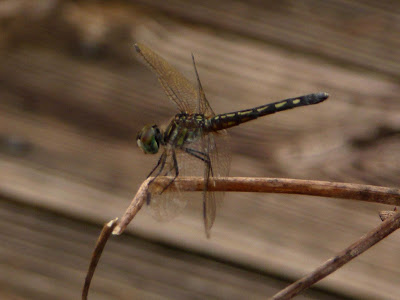 |
| Wild Honey Bees, Apis mellifera |
 |
| Honey Bees Clustering on Hive |
 |
| Honey bee hive hanging from abandoned oil field equipment. |
 |
| The dark ball hanging under the center of the broken ramp is the bee colony. |
The Master Naturalists finished sprigging a mess of Eastern Gamagrass and bumping up Yellow Indiangrass seedlings. We had extra time on this last workday before Christmas, so the Nature Conservancy Technician, Tim O'Connell, treated us to a ride out on the Prairie. He promised to show us something special. From the pick-up truck, we saw hawks, sparrows, killdeer, geese, caracaras, and an osprey, but the surprise was a hive of wild honey bees!
We were in a remote part of the prairie preserve. Tim pointed out a dark mass hanging beneath a piece of abandoned oil field metalwork. As we approached, we could see the honey bees clinging to curtains of wax comb. We moved slowly and kept our distance. Although it was wintertime, astronomically speaking, the air temperature was in the 70s F, plenty warm enough for bees to fly in defense of the hive if they perceived us as a threat.
The Honey Bee, Apis mellifera, is revered on this planet for unsurpassed pollinating skills, as well as honey and wax production. The subspecies, A.m ligustica, is the most common western honey bee in Texas. Africanized Honey Bees, which also live in Texas, encompass different subspecies, such as A.m. intermissa. You cannot distinguish one type of honey bee from another other just by looking at them. However, the Africanized Honey Bees are much more aggressive in defending their hive than are the western honey bees.
Wild bees often make their nests in the hollow of a tree; Live Oaks, which keep their leaf canopy year 'round, are popular. The bees look for a spot that will be within easy flying distance of water, pollen and nectar. They also favor a location that offers some protection from the weather. Because there are not many trees on the Texas City Prairie Preserve, these insects had to be resourceful. The colony will live through the winter, surviving the cold days by clustering together. We were delighted to see this healthy hive of pollinators on the prairie.
This is a brand new subject for me. If you like, you can read more about bees here:













































